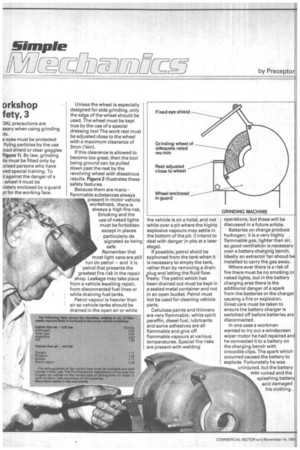orkshop fety, 3
Page 66

If you've noticed an error in this article please click here to report it so we can fix it.
:IAL precautions are ssary when using grinding ?Is.
e eyes must be protected flying particles by the use ixed shield or clear goggles Figure 1). By law, grinding ?Is must be fitted only by Prised persons who have ved special training. To d against the danger of a :wheel it must be Pletely enclosed by a guard pt for the working face. Unless the wheel is especially designed for side grinding, only the edge of the wheel should be used. The wheel must be kept true by the use of a special dressing tool The work rest must be adjusted close lathe wheel with a maximum clearance of 3mm Wain).
If this clearance is allowed to become too great, then the tool being ground can be pulled down past the rest by the revolving wheel with disastrous results. Figure 2 illustrates these safety features.
Because them are many flammable substances always present in motor vehicle workshops, there is always a high fire risk.
Smoking and the use of naked lights must be forbidden except in places particularly de signated as being safe.
Remember that most light vans are still run on petrol — and it is petrol that presents the greatest fire risk in the repair shop. Leakage may take place from a vehicle awaiting repair, from disconnected fuel lines or while draining fuel tanks.
Petrol vapour is heavier than air so vehicle tanks should be drained in the open air or while the vehicle is on a hoist, and not while over a pit where the highly explosive vapours may settle in the bottom of the pit. (I intend to deal with dangerin pits at a later stage).
If possible, petrol shold be syphoned from the tank when it is necessary to empty the tank, rather than by removing a drain plug and letting the fluid flow 'freely. The petrol which has been drained out must be kept in a sealed metal container and not in an open bucket. Petrol must ot be used for cleaning vehicle parts.
Cellulose paints and thinners are very flammable; white spirit paraffin, diesel fuel, lubricants and some adhesives are all flammable and give off flammable vapours at various temperatures. Special fire risks are present with welding
operations, but these will be discussed in a future article.
Batteries on charge produce hydrogen; it is a very highly flammable gas, lighter than air, so good ventilation is necessary over a battery cha'Ning bench. Ideally an extractor fan shoud be installed to carry the gas away.
Where ever there is a risk of fire there must be no smoking or naked lights, but in the battery charging area there is the additional danger of a spark from the batteries or the charger causing a fire or explosion. Great care must be taken to ensure the battery charger is switched off before batteries are disconnected.
In one case a workman wanted to try out a windscreen wiper motor he had repaired and he connected it to a battery on the charging bench with crocodile clips. The spark which occurred caused the battery to explode. Fortunately he was uninjured, but the battery was ruined and the splashing battery acid damaged his clothing.,






















































































